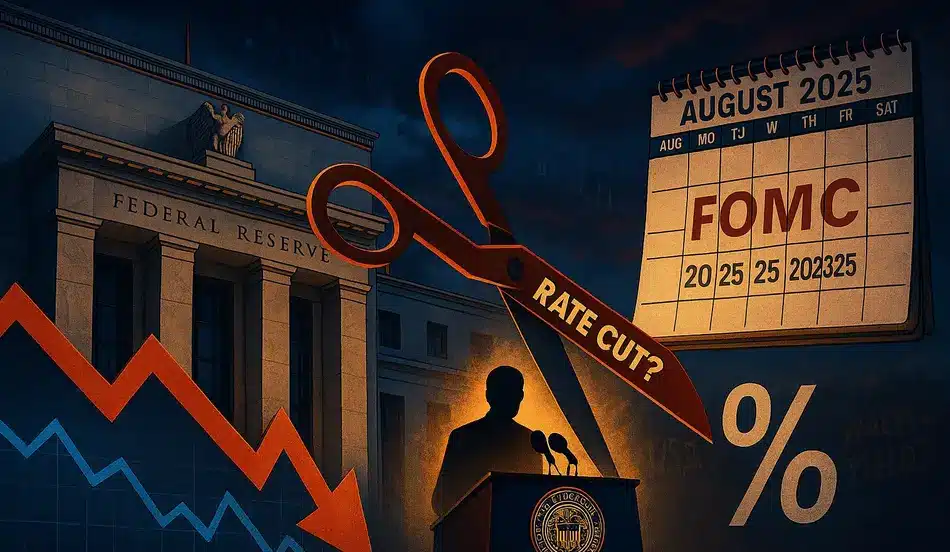The Revised Jobs Data Revolution
The Federal Reserve economic policy 2025 landscape shifted dramatically when revised employment figures revealed a much weaker labor market than initially reported. These revisions have created a complex scenario where policymakers must balance the dual mandate of price stability and maximum employment under increasingly uncertain conditions.
The revised data shows unemployment approaching 4.3%, a significant departure from earlier optimistic projections. This development has forced even the most hawkish Fed officials to reconsider their stance on monetary policy, particularly regarding the timing of potential rate cuts.
Atlanta Fed President’s Pivotal Shift
Atlanta Federal Reserve President Raphael Bostic’s recent comments represent a seismic shift in Federal Reserve economic policy 2025 thinking. Previously forecasting stagflation and opposing rate cuts entirely, Bostic’s acknowledgment of potential September cuts signals a fundamental reassessment of economic conditions.
This change is particularly significant because Bostic was among the most conservative voices on the Federal Open Market Committee, often expressing concerns about inflationary pressures. His shift toward supporting rate cuts indicates that employment concerns are now outweighing inflation fears among key policymakers.
Looking to Hire Fast?
Hiring managers can now post jobs for free on WhatJobs and connect with millions of jobseekers.
Post a Job Now →The Employment Mandate Takes Center Stage
The Federal Reserve economic policy 2025 is increasingly focused on the employment side of its dual mandate as labor market indicators continue to deteriorate. The unemployment rate’s upward trajectory, combined with declining labor force participation, has created a perfect storm for dovish monetary policy.
Recent data reveals that 1.5 million foreign-born workers have left the workforce since April, representing a significant constraint on labor supply. This exodus, combined with accelerating retirements among baby boomers, has created artificial stability in unemployment figures while masking underlying economic weakness.
Baby Boomer Retirement Acceleration
The retirement wave among baby boomers is accelerating Federal Reserve economic policy 2025 concerns. Many workers are taking Social Security benefits earlier than planned, often due to fears about future benefit availability. This trend is creating additional pressure on the labor market and complicating the Fed’s assessment of true employment conditions.
Tariff Policy’s Moving Target Problem
Federal Reserve economic policy 2025 faces additional complexity from the evolving tariff landscape. Unlike previous economic cycles, current policymakers must account for trade policy impacts that can change rapidly based on political decisions rather than economic fundamentals.
However, recent clarity on tariff levels provides some stability for Federal Reserve economic policy 2025 calculations. The 15% tariff rate appears to be the new baseline that policymakers can incorporate into their models, reducing uncertainty about future inflationary pressures from trade policy.
Fed Chair Powell’s Tariff Assessment
Federal Reserve Chair Jerome Powell has provided crucial guidance on how tariff impacts should factor into Federal Reserve economic policy 2025 decisions. His assessment that the 15% rate represents a stable baseline allows policymakers to focus on other economic indicators without constant tariff-related adjustments.
The Risk Balancing Act
Federal Reserve economic policy 2025 requires an unprecedented balancing act between inflation and employment risks. Current conditions present policymakers with the challenge of determining which mandate component is furthest from target and requires immediate attention.
The current assessment suggests that employment concerns may outweigh inflation risks, particularly given the revised jobs data and accelerating labor market deterioration. This shift has prompted key Fed governors, including Christopher Waller and Michelle Bowman, to express confidence that tariff-related inflation will be transitory rather than persistent.
Governor Waller’s Transitory Inflation Confidence
Federal Reserve Governor Christopher Waller’s recent statements reflect growing confidence that tariff-related inflation will be temporary. This assessment is crucial for Federal Reserve economic policy 2025 because it allows policymakers to prioritize employment concerns without fearing persistent inflationary pressures.
The September Rate Cut Probability
Federal Reserve economic policy 2025 is increasingly pointing toward a September rate cut, though it remains far from certain. The combination of revised employment data, accelerating retirements, and stable tariff expectations has created conditions favorable for monetary easing.
However, the Federal Reserve economic policy 2025 decision-making process remains complex, requiring careful consideration of multiple economic indicators and their interactions. The Fed must weigh the benefits of supporting employment against the risks of reigniting inflationary pressures.
Market Expectations and Fed Communication
Market participants are increasingly pricing in September rate cuts, reflecting growing confidence in Federal Reserve economic policy 2025 dovishness. This expectation creates additional pressure on policymakers to deliver on market expectations while maintaining credibility in their inflation-fighting commitment.
The Labor Supply Constraint Factor
Federal Reserve economic policy 2025 must account for unprecedented labor supply constraints that are artificially stabilizing unemployment figures. The loss of 1.5 million foreign-born workers represents a significant shock to the labor market that traditional models may not fully capture.
This constraint creates a unique challenge for Federal Reserve economic policy 2025 because it masks underlying economic weakness while potentially creating inflationary pressures through labor shortages. Policymakers must determine whether these constraints are temporary or represent a structural change in the labor market.
Immigration Policy’s Economic Impact
The relationship between immigration policy and Federal Reserve economic policy 2025 has become increasingly important as labor supply constraints intensify. Recent changes in immigration patterns are directly affecting the Fed’s ability to achieve its employment mandate, creating additional complexity for monetary policy decisions.
Looking to Hire Fast?
Hiring managers can now post jobs for free on WhatJobs and connect with millions of jobseekers.
Post a Job Now →The Path Forward for Monetary Policy
Federal Reserve economic policy 2025 faces a critical juncture where traditional policy tools may prove insufficient for addressing current economic challenges. The combination of labor supply constraints, tariff impacts, and demographic changes requires innovative approaches to monetary policy.
The Fed’s ability to navigate these challenges will determine the trajectory of the U.S. economy for years to come. Success will require careful communication, flexible policy approaches, and willingness to adapt to rapidly changing economic conditions.
Communication Strategy Evolution
Federal Reserve economic policy 2025 communication strategies must evolve to address the complexity of current economic conditions. Policymakers must clearly explain their reasoning while maintaining flexibility to respond to new data and changing circumstances.
The Federal Reserve economic policy 2025 landscape represents one of the most challenging periods in central banking history. As policymakers navigate the dual mandate under unprecedented conditions, their decisions will shape the economic trajectory for millions of Americans and global markets alike.
Frequently Asked Questions
Q: How does Federal Reserve economic policy 2025 differ from previous years?
A: Federal Reserve economic policy 2025 faces unique challenges including labor supply constraints from immigration changes, tariff impacts, and demographic shifts that weren’t present in previous economic cycles. The combination of these factors requires more nuanced policy approaches than traditional models suggest.
Q: What role do tariffs play in Federal Reserve economic policy 2025 decisions?
A: Tariffs create a moving target for Federal Reserve economic policy 2025 by introducing trade-related inflationary pressures that can change rapidly based on political decisions. However, the current 15% baseline provides some stability for policy calculations.
Q: How do labor supply constraints affect Federal Reserve economic policy 2025?
A: Labor supply constraints, particularly the loss of 1.5 million foreign-born workers, artificially stabilize unemployment figures while potentially creating inflationary pressures through labor shortages. This creates a unique challenge for Federal Reserve economic policy 2025 that traditional models may not capture.
Q: What is the likelihood of September rate cuts in Federal Reserve economic policy 2025?
A: While not guaranteed, Federal Reserve economic policy 2025 is increasingly pointing toward September rate cuts due to revised employment data, accelerating retirements, and growing concerns about employment stability outweighing inflation




